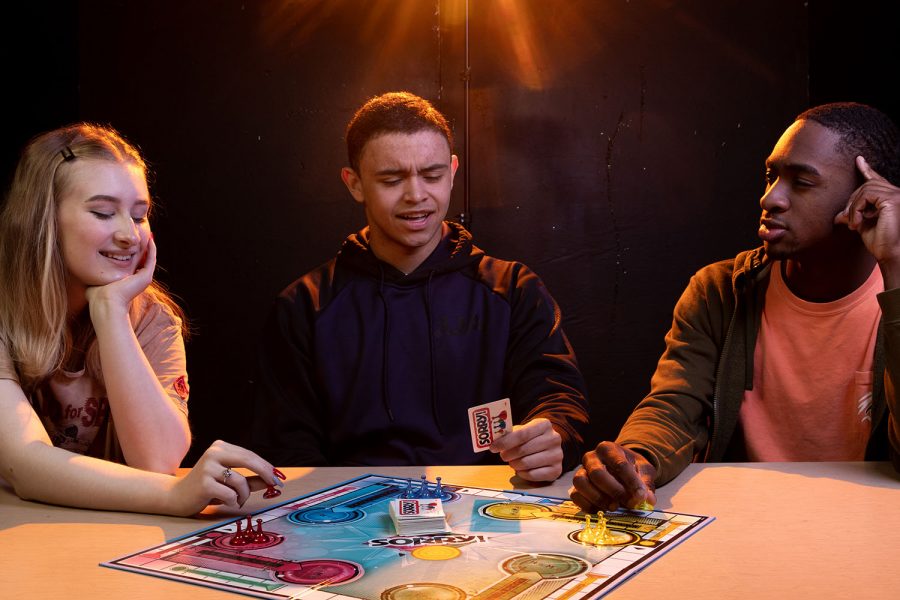Evolution of board games
How board games have changed over the years
Photo by Oren Smith
April 30, 2019
Once the main attraction for rainy days, board games still attract lots of attention from youth today. Most board games have one thing in common: completing an objective results in one becoming the winner. Board games have changed throughout the years to entice the current youngest generation.
Early 1900s
While some may see Monopoly as a boring, time-consuming game with little action, the roots of Monopoly have a deeper message. Made in 1903, Monopoly was made to promote the idea that an economy with taxation and consumer choice is more effective than one where a small percentage controls most by showing the evils of a monopoly. Although this underlying persuasion may not apply nowadays, Monopoly is still a fun game to play when one is stuck inside for a few hours.
Mid 1900s
Risk is arguably one of the most strategic games ever made — it requires both patience and playing dice correctly to succeed. Various forms of Risk have been made in the years since it first came out in 1959, including 18th Century, Transformers and Star Wars versions among others. Risk is not for the faint of heart — one wrong move can lead to the downfall of an empire.
1980s
Although technically not a “board” game, Jenga’s simplicity has appealed to all generations and ages. To play Jenga, one must be willing to make risky moves in order to undermine the competing players. Jenga is a great game to play with little time, if one is willing to reset the tower each time.
1990s
Originating in 1995, Catan became one of the first German-made games to gain popularity excluding Europe. Catan is played on a honeycomb-style board. Players are assigned specific regions and must employ strategy to obtain the 10 points needed to win. Like Risk, players must be willing to be patient and strategic in their placement of items.
2000s
Tetris lovers, this one’s for you. Like Tetris, Blokus utilizes abstract shapes in its game. Unlike Tetris, however, same colors cannot touch except at the edges, leading to a uniquely colored board by the end. While the original Blokus involves 2-4 players on a square board, other versions exist, including Blokus Trigon (triangles) and Travel Blokus.
2010s
In a generation unlike the rest, kids’ desire to play board games often has been superseded by likings of new silly “board” games. Pie in the face is not an exception; the plot of the game is the suspense of, well, being pied in the face. There are some pros to this genre of games, the whipped cream used in Pie in the Face can, in fact, be eaten.

















taaaaraaaa • Sep 3, 2024 at 12:58 pm
you should add how it Chang as a collocation
Harold Burton • Sep 28, 2021 at 11:41 am
I’m so excited for the SNES Classic, and even though I didn’t get a preorder it would have been great if these top 25 games would have been the preloaded one (Although most are). The only ones I felt deserved a spot were Actrasier, Mario Paint, Krustys Super Fun House, Killer Instinct and God forgive me Bubsy. I mean those were some of my SNES games of my childhood and I still think they’re great (No matter what anyone says) Overall though to this day I think the SNES was the best video game system to date!
Harold Burton
Ashley Jones • Sep 5, 2021 at 10:27 pm
am i the only one that played “”B.O.B”” and thought it should have been number two??? (lets face it Zelda deserved to be number one all day long) or at least on the list at the very least…. i mean a robot going through all that to get his dipstick oily is just to much fun…
CrazyAsk
Joseph Donahue • Aug 29, 2021 at 6:05 pm
A Link to the Past should not be #1, in my opinion. The concept of the Zelda games is not suitable for everyone. I had to use walkthroughs for Ocarina of Time, and now I’m wondering why it’s suddenly regarded as one of the greatest games ever, especially with all the hullabaloo about the Water Temple. Super Mario World on the other hand, has a easy to use/understand concept of just making it to the end of a level, with no frustrating no-hints given puzzles that you can learn from and not get frustrated with from getting lost, and again, was a pack-in game. Arguably the best of all games packaged with systems.
Joseph Donahue
Harold Burton • Jul 27, 2021 at 11:19 pm
Never watched this video, I predicted Super Mario World at #1! And LITERALLY just as I was typing this, Super Mario World was #2? I’m actually surprised by WatchMojo this time! After that though I knew a Zelda game was #1 and I’m not surprised by that at all! Also no Kirby Super Star? Not even an honorable mention? And I would but the whole Super Nintendo DK Country trilogy in 1 spot! Again, only the Super Nintendo ones, for anyone who misread that!
Harold Burton
Alisha Ross • Jul 8, 2019 at 10:47 pm
cheating was never cool, you just ruin other people’s day.
if you want to use cheats, go play offline games and enjoy the game for yourself and not ruin anyone’s day.
Regards
Ross Alisha
Moses Brodin • Jul 3, 2019 at 11:45 pm
Seriously though this game is so boring, uncensored would have been the only way it would have been interesting enough to play. Whats the point of sensoring a dating sim?
Ragerds:Moses Brodin